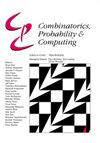On the zeroes of hypergraph independence polynomials
IF 0.8
4区 数学
Q3 COMPUTER SCIENCE, THEORY & METHODS
引用次数: 0
Abstract
Abstract We study the locations of complex zeroes of independence polynomials of bounded-degree hypergraphs. For graphs, this is a long-studied subject with applications to statistical physics, algorithms, and combinatorics. Results on zero-free regions for bounded-degree graphs include Shearer’s result on the optimal zero-free disc, along with several recent results on other zero-free regions. Much less is known for hypergraphs. We make some steps towards an understanding of zero-free regions for bounded-degree hypergaphs by proving that all hypergraphs of maximum degree $\Delta$ have a zero-free disc almost as large as the optimal disc for graphs of maximum degree $\Delta$ established by Shearer (of radius $\sim 1/(e \Delta )$ ). Up to logarithmic factors in $\Delta$ this is optimal, even for hypergraphs with all edge sizes strictly greater than $2$ . We conjecture that for $k\ge 3$ , $k$ -uniform linear hypergraphs have a much larger zero-free disc of radius $\Omega (\Delta ^{- \frac{1}{k-1}} )$ . We establish this in the case of linear hypertrees.关于超图无关多项式的零点
摘要研究了有界次超图的独立多项式复零的位置。对于图,这是一个长期研究的主题,应用于统计物理、算法和组合学。关于有界度图无零区域的结果包括Shearer关于最优无零圆盘的结果,以及最近关于其他无零区域的一些结果。对于超图的了解要少得多。通过证明所有最大度超图$\Delta$都有一个几乎与Shearer(半径为$\sim 1/(e \Delta )$)建立的最大度图$\Delta$的最优圆盘一样大的零自由圆盘,我们在理解有界度超图的零自由区域方面迈出了一些步骤。对于$\Delta$中的对数因子,这是最优的,即使对于所有边大小都严格大于$2$的超图也是如此。我们推测对于$k\ge 3$, $k$ -均匀线性超图有一个更大的半径为$\Omega (\Delta ^{- \frac{1}{k-1}} )$的零自由盘。我们在线性超树的情况下证明了这一点。
本文章由计算机程序翻译,如有差异,请以英文原文为准。
求助全文
约1分钟内获得全文
求助全文
来源期刊

Combinatorics, Probability & Computing
数学-计算机:理论方法
CiteScore
2.40
自引率
11.10%
发文量
33
审稿时长
6-12 weeks
期刊介绍:
Published bimonthly, Combinatorics, Probability & Computing is devoted to the three areas of combinatorics, probability theory and theoretical computer science. Topics covered include classical and algebraic graph theory, extremal set theory, matroid theory, probabilistic methods and random combinatorial structures; combinatorial probability and limit theorems for random combinatorial structures; the theory of algorithms (including complexity theory), randomised algorithms, probabilistic analysis of algorithms, computational learning theory and optimisation.
 求助内容:
求助内容: 应助结果提醒方式:
应助结果提醒方式:


